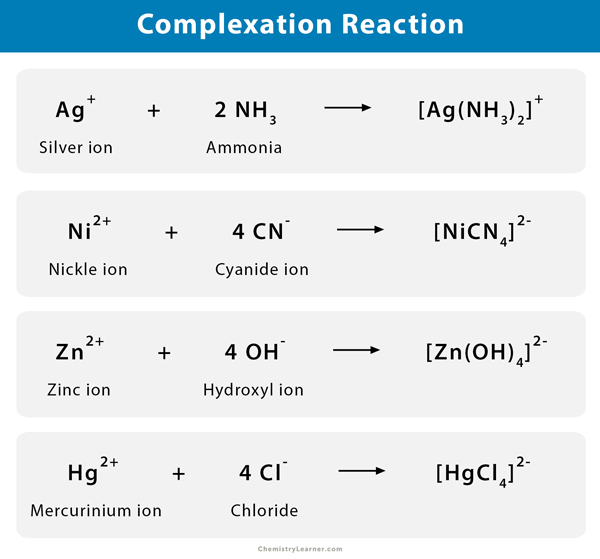Complexation Reaction
What is a Complexation Reaction?
A complexation reaction can be described as a reaction that forms a complex compound. It is also known as a complex formation reaction. A complex is defined as a molecular structure that consists of a metal atom or ion in the center, surrounded by ligands. It can be positively charged, neutral, or negatively charged. The overall charge on the complex depends on the oxidation state of the metal and the charges brought by the ligands. The complexation reaction is a test carried out to detect the presence of complex cations [1].
The general equation of a complexation reaction equilibrium is represented as:
M + L ⇌ ML
Where M is a metal, and L is a ligand.
Examples of Complex Ion
Complexes generally form around a transition metal cation (for example, Ni2+, Au3+, and Cu+). A color change indicates the formation of a complex. Most complexes are brightly colored.
Here are some examples of complex ions [2]:
- If a complex ion forms between a Fe2+ ion and six CN– ligands, the complex will have a -4 charge, and the formula is written [Fe(CN)6]4-.
- If a complex ion forms between an Ag+ ion and two NH3 ligands, the complex will have a +1 charge, and the formula is written [Ag(NH3)2]+
- Likewise, [Cu(CN)2]–, [Mn(OH2)6]2-, and [Al(H2O)6]3+
Examples of Complexation Reaction
Here are some examples of complexation reactions [1-3]:
- Adding a cobalt salt, such as cobalt chloride (CoCl2), to water (H2O)
CoCl2 (s) + 6 H2O (l) → [Co(H2O)6]2+ (aq.)
- Adding copper sulfate (CuSO4) to water (H2O)
CuSO4 (s) + 6 H2O (l) → [Cu(H2O)6]2+ (aq.)
- Adding aqueous ammonia (NH3) to [Cu(H2O)6]2+ replaces the water molecule
[Cu(H2O)6]2+ (aq.) + 4 NH3 (aq.) → [Cu(NH3)4]2+ (aq.)
- Adding excess ammonia to nickel (II) ions
Ni2+ (aq.) + 4 NH3 (aq.) → [Ni(NH3)4]2+ (aq.)
Applications of Complexation Reaction
The complexation reaction has many uses in analytical chemistry, but its primary use is in titrating cations. Titration takes place between the analyte and titrant. This technique is used in the food industry. It allows food manufacturers to determine the quality of reactants in a sample. For example, it can determine how much salt or sugar is present in a product [4-6].
